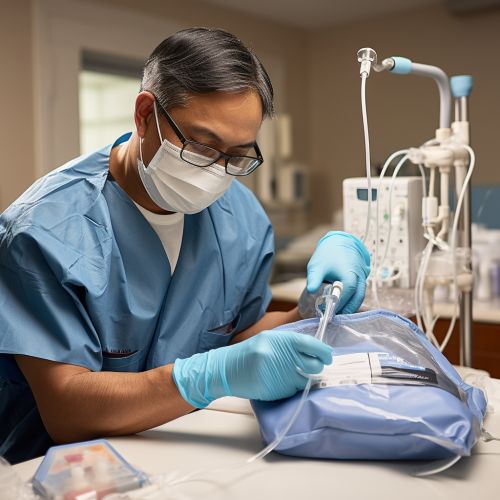Hyperthermia
Definition and Overview
Hyperthermia, also known as heatstroke, is a severe heat-related illness characterized by an elevated body temperature greater than or equal to 40.0°C (104.0°F) due to environmental heat exposure with lack of thermoregulationthermoregulation. This is distinct from fever, where there is a physiological increase in the temperature set point of the body. Hyperthermia is a medical emergency that requires immediate treatment to prevent disability or death.


Causes
Hyperthermia can be caused by a variety of factors, including exposure to high ambient temperatures, strenuous physical activity, wearing heavy or restrictive clothing, and certain medications or substances. It can also occur as a result of conditions that impair the body's ability to regulate its temperature, such as advanced age, obesity, heart disease, and certain neurological disorders.
Pathophysiology
The human body normally maintains a stable internal temperature through a balance of heat production and heat loss. Heat is produced by metabolic processes in the body's cells, and is lost through radiation, conduction, convection, and evaporation. When the body's temperature regulation mechanisms are overwhelmed by heat load, hyperthermia can occur.
Symptoms
Symptoms of hyperthermia can vary depending on the severity of the condition, but may include hot, dry skin, rapid heartbeat, shallow breathing, confusion or disorientation, and loss of consciousness. Severe hyperthermia can lead to organ damage, seizures, coma, and death.
Diagnosis
Diagnosis of hyperthermia is based on a combination of clinical symptoms and a body temperature greater than 40.0°C (104.0°F). Additional tests may be conducted to assess organ function and to rule out other conditions that may cause similar symptoms.
Treatment
Treatment of hyperthermia involves reducing the body's temperature to normal levels as quickly as possible. This can be achieved through a variety of methods, including removing the person from the heat source, applying cool or tepid water to the skin, using cooling blankets, and administering intravenous fluids to prevent dehydration.


Prevention
Prevention of hyperthermia involves avoiding exposure to high temperatures, staying hydrated, wearing light, loose-fitting clothing, and taking regular breaks during strenuous activity. Certain groups, such as the elderly, children, and those with chronic illnesses, may be more susceptible to hyperthermia and should take extra precautions.
Prognosis
The prognosis for hyperthermia depends on the severity of the condition and the speed at which treatment is initiated. With prompt and appropriate treatment, most people recover fully from hyperthermia. However, severe or prolonged hyperthermia can result in permanent organ damage or death.
